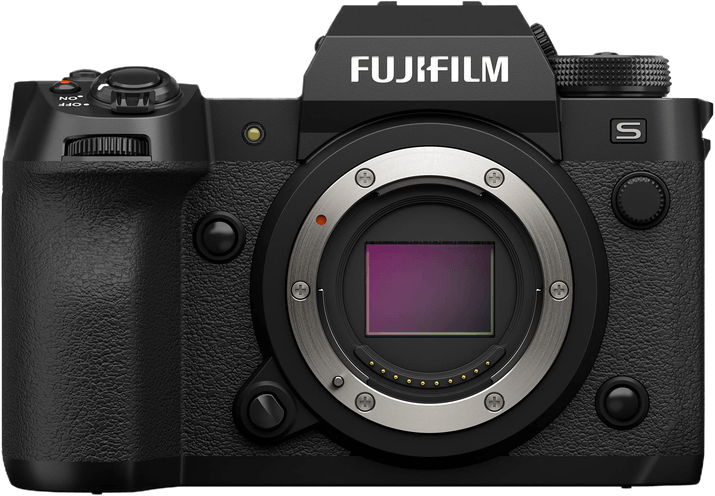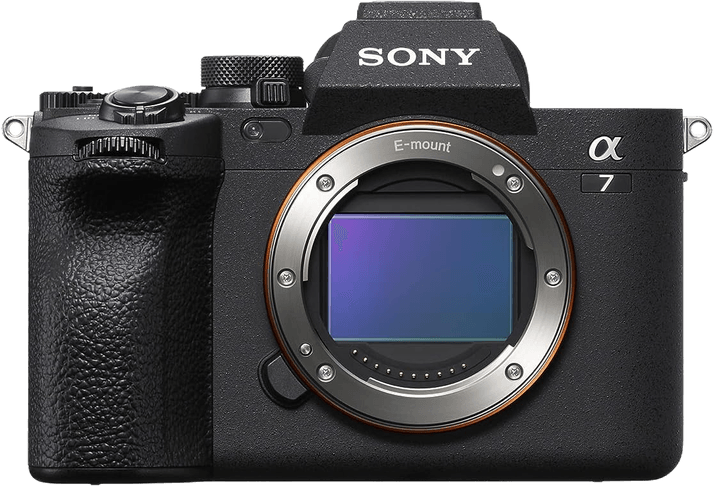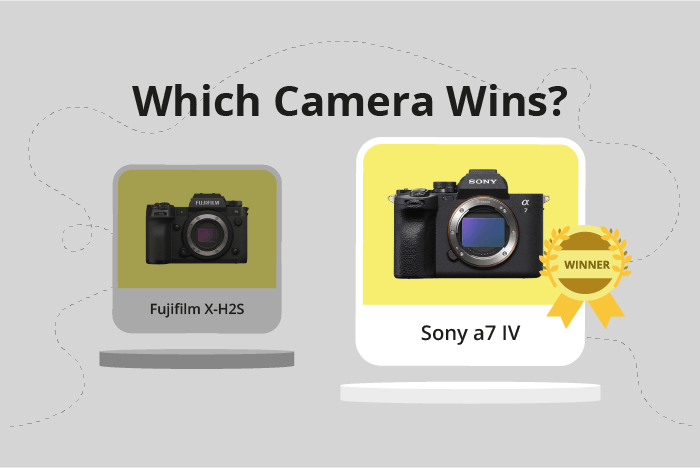Fujifilm X-H2S vs Sony a7 IV Comparison
Fujifilm X-H2S

Sony a7 IV

The Sony a7 IV outperforms the Fujifilm X-H2S with a score of 84/100 compared to 79/100. Both cameras are mirrorless and launched within a year of each other, with the X-H2S releasing in 2022 and the a7 IV in 2021. They share similar launch prices, around $2500, and are almost equal in weight and size.
The Sony a7 IV excels due to its superior performance, making it the better option. On the other hand, the Fujifilm X-H2S has its own merits, but it falls short in comparison to the a7 IV.
Considering the scores and specifications, the Sony a7 IV emerges as the winner in this comparison, offering more value for its price.
Fujifilm X-H2S vs Sony a7 IV Overview and Optics
The Sony a7 IV outperforms the Fujifilm X-H2S in optics, with a score of 85/100 compared to the Fujifilm’s 77/100. Both cameras share some common specifications, including CMOS sensors, image stabilization, and lens mounts that are specific to their respective brands. Despite these similarities, the Sony a7 IV has distinct advantages that contribute to its higher score.
One advantage of the Sony a7 IV is its higher megapixel count at 33 compared to the Fujifilm X-H2S’s 26 megapixels. This results in the Sony a7 IV producing higher resolution images. Additionally, the Sony a7 IV features a full-frame sensor, which allows for better low-light performance and increased dynamic range compared to the Fujifilm X-H2S’s APS-C sensor. The Sony a7 IV also boasts a DXOMARK score of 97 for its sensor, while the Fujifilm X-H2S lacks a DXOMARK score as the organization does not test Fujifilm cameras.
The Fujifilm X-H2S, however, has a faster shooting speed of 40 frames per second compared to the Sony a7 IV’s 10 frames per second. This makes the Fujifilm X-H2S better suited for capturing fast-moving subjects and action photography.
Taking into account these differences, the Sony a7 IV is the winner in optics due to its higher resolution, full-frame sensor, and impressive DXOMARK score. Although the Fujifilm X-H2S has a faster shooting speed, it falls short in other aspects of optical performance. Consequently, the Sony a7 IV is the superior choice for those prioritizing image quality and low-light capabilities, while the Fujifilm X-H2S may be more suitable for action photography enthusiasts.
Fujifilm X-H2S vs Sony a7 IV Video Performance
The Fujifilm X-H2S and Sony a7 IV are both excellent cameras for video, but the Sony a7 IV takes the lead with a video score of 91/100, compared to the Fujifilm X-H2S’s score of 83/100. These two cameras share key video features, including 4K video resolution and built-in time-lapse functionality.
Despite having the same 4K video resolution, the Sony a7 IV has an advantage with its maximum video dimensions of 3840 x 2160, while the Fujifilm X-H2S offers 4096 x 2160. This difference in dimensions provides the Sony a7 IV with a wider aspect ratio, making it more suitable for cinematic video recording. Furthermore, the Sony a7 IV surpasses the Fujifilm X-H2S in terms of maximum video frame rate, offering an impressive 120fps, while the Fujifilm X-H2S reaches up to 60fps. This higher frame rate allows for smoother slow-motion footage in the Sony a7 IV.
On the other hand, the Fujifilm X-H2S does not offer significant advantages over the Sony a7 IV in terms of video capabilities. Both cameras have 4K resolution and time-lapse functionality, but the Sony a7 IV outperforms the Fujifilm X-H2S in video dimensions and frame rate.
Considering these factors, the Sony a7 IV is the clear winner in terms of video performance, with its superior video dimensions and frame rate. The Fujifilm X-H2S, while a solid choice for video recording, falls short in comparison to the Sony a7 IV’s capabilities. For those seeking the best video performance, the Sony a7 IV is the top choice.
Fujifilm X-H2S vs Sony a7 IV Features and Benefits
The Fujifilm X-H2S wins the feature comparison with a score of 85 out of 100, while the Sony a7 IV scores 83 out of 100. Both cameras share several specifications, making them quite similar in terms of features. They both have a 3-inch screen, touchscreen capabilities, a flip screen, WiFi, Bluetooth, and neither has GPS.
The Fujifilm X-H2S takes the lead in this comparison mainly due to its superior screen resolution of 1,620,000 dots, compared to the Sony a7 IV’s 1,040,000 dots. This higher resolution allows for a clearer and more detailed display, which can be helpful when reviewing images or navigating the camera’s menus.
While the Sony a7 IV does not surpass the Fujifilm X-H2S in any specific feature, it still remains a strong contender due to its overall high-quality specifications. It is important to note that the difference in score is minimal, with only a two-point difference. This indicates that both cameras are well-rounded and offer a great set of features for photographers.
When considering the Fujifilm X-H2S and Sony a7 IV, it is clear that both cameras are strong options with a wide range of features. The Fujifilm X-H2S has an advantage in screen resolution, while the Sony a7 IV still offers an impressive set of features with only a slight difference in score. Ultimately, the decision between these two cameras will come down to individual preferences and priorities.
Fujifilm X-H2S vs Sony a7 IV Storage and Battery
The Fujifilm X-H2S and Sony a7 IV tie in storage and battery with scores of 76/100. Both cameras offer two memory card slots and USB charging capabilities. They also share the same battery life of 580 shots.
The X-H2S accepts CFexpress Type B and SD (UHS-II compatible) memory cards, while the a7 IV uses CFexpress Type A and SD (UHS-II compatible) cards. The Fujifilm X-H2S has a slight advantage with its use of the faster CFexpress Type B cards, providing quicker data transfer rates.
On the other hand, the Sony a7 IV’s CFexpress Type A cards are smaller and lighter, which can be beneficial for photographers looking to reduce their gear load. The a7 IV uses an NP-FZ100 battery, while the X-H2S uses an NP-W235 battery; however, this difference does not affect their equal battery life.
Ultimately, both cameras excel in storage and battery performance, with the Fujifilm X-H2S holding a minor edge in speed due to its CFexpress Type B compatibility. The Sony a7 IV offers a more compact solution with its use of CFexpress Type A cards.
Fujifilm X-H2S vs Sony a7 IV – Our Verdict
Are you still undecided about which camera is right for you? Have a look at these popular comparisons that feature the Fujifilm X-H2S or the Sony a7 IV:

